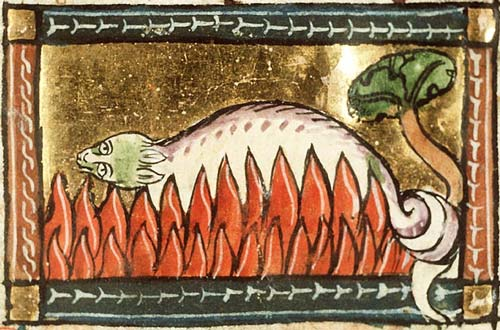A Scottish Salamander in the Loch?
Posted by: Nick Redfern on September 6th, 2012

Those fascinated by the mystery of the Loch Ness Monster should definitely check out the new blog from Steve Plambeck. Unlike a lot of blogs and websites on Nessie that focus on a wide range of theories for the beasts of the loch, Steve’s is devoted to one theory, and one alone: namely, that perhaps the animals are giant salamanders. Since this is a new blog, there are only a couple of posts up so far, but Steve has already provided us with some intriguing analysis of a very famous photo…
About Nick Redfern
Punk music fan, Tennents Super and Carlsberg Special Brew beer fan, horror film fan, chocolate fan, like to wear black clothes, like to stay up late. Work as a writer.










This is the most reasoned and best-developed article I have ever read on this subject. I encourage all readers to carefully read this in its entirety and study the images provided.
I like the idea, but was always skeptical of that picture-it DOES look like a yellow Labrador retriever with a stick in its mouth swimming towards the camera.
I like the ideas put forth, and they are well supported arguments. I also have no trouble with the idea of a salamander in the loch. However, I do have some issues with this whole hypothesis.
The first and main problem I have is that the whole argument seems to rest on the one photo and what is perceived to be shown in it. This can be a tricky proposition on several levels. First, is the photo being looked at from all angles? I’ve seen the very same photo be “proven” to be a dog carrying a stick through similar analysis. Is it possible that anything other than a salamander could have produced the same effects shown, and are those options being equally assessed?
Second, it presumes that this particular photo is in fact genuine. The problem here is that there are many pieces of purported photographic evidence of Nessie, but it is unclear which ones are hoaxes, known mundane objects, or possible photos of an undiscovered animal. Unless we knew for a fact which ones are which, which let’s face it we don’t, it doesn’t seem to be scientifically valid to home in on one photo as being genuine and treat it as somehow the key to the whole phenomenon. This sort of thing can in fact muddy our data and potentially lead us away from the truth. If we presume that out of all of the photos of Nessie this one is an un-hoaxed, actual photo, and form serious arguments and observations on it, then we are running the risk of basing our data on an unreliable source and it becomes hard to treat anything as concrete. There is a reason science is so careful and wary of accepting new data as fact.
The fact of the matter is that there are purported Nessie photos showing a wide range of different things, some of which do not seem to show a salamander (or otters for that matter 😉 ) no matter how you look at it. Can we seriously discount any photo that may not fit into the salamander hypothesis and instead hold the one that does fit that idea up as real? I just don’t feel comfortable doing that. If we are to admit photographic evidence in the first place, then it seems to me that until we know for sure what we are looking at in a photo, all photographic evidence must be more or less treated in an open minded, unbiased way. I think we should not latch onto the ones that fit a particular pet theory and give them more weight.
In addition to making this photo, or any others that fit a salamander hypothesis for that matter, the “real” photos that we should be looking at, there is another problem in eyewitness evidence. Nessie sightings describe a wide variety of things, and many reports of Nessie seem to describe something that does not always seem to fit the description of any kind of salamander. Can we favor reports of something salamander-like over ones that aren’t? If we are to go with the salamander hypothesis, then again we are discounting other eyewitness reports that may not fit into that idea. By accepting the photo that fits the salamander hypothesis, we discount any reports that in fact do mention a long neck or a creature that is distinctly different from this type of animal. I feel that until we have all of the facts, we should not throw out any data which may not sit well with our own hypotheses.
This is a very good analysis of that photo, I will give it that. One of the better photographic analyses of a cryptid I’ve seen in a while, I’d even say. It is a thorough, well thought out argument, but it also seems to make some assumptions that I’m not sure can hold up to the Loch Ness phenomenon as a whole. I don’t feel like we know enough about this phenomenon to pick and choose the evidence or data that we treat as valid. It is good to look at angles like this and support them as solidly as has been done here, but there are other angles to look at and weigh them against. With as little as we know about Nessie, I’d discourage embracing this idea so thoroughly and thereby throwing out of any photo or eyewitness testimony that does not fit in with the salamander hypothesis just yet.
An additional thing is that although the salamander theory is interesting, I also wonder whether this kind of creature could apply to Loch Ness. It is true that there are very large salamanders, for example giant salamanders in Japan. They are large, they do live in cold water environments, and would certainly be strange looking to someone who was not expecting to see one, but there are several things I wonder about with regards to Nessie being something like this.
One is size. Although Japanese giant salamanders get quite large, they are nowhere near the dimensions described in most Nessie reports. Not even close. Certainly, there is no real reason to think there could not be larger species of salamander lurking about, but it is important to realize just how much of an order of magnitude bigger the creature described in most Nessie reports is compared to the largest living salamander we know of today. Gigantism does occur and in fact the Japanese giant salamander is an example of this. However, there would have to be some considerable underlying biological factors at work to cause such an extreme case of one getting huge enough to produce Nessie reports. I’m not sure if there are factors in place in Loch Ness that would trigger such extreme gigantism.
This is not necessarily a reason to discount the salamander hypothesis, but it is something to think about nevertheless. Giant salamanders also are not fast moving creatures and tend to stay in one place on the bottom rather than swimming relatively rapidly at the surface as in many Nessie reports.
Also, Japanese giant salamanders live in cold, fast moving streams because this helps them absorb oxygen from the water. There is a pattern to be seen here, as hellbenders, another type of very large salamander, also live in shallow, fast moving streams. These creatures require a constant, steady flow of easily absorbed dissolved oxygen which these kinds of conditions facilitate. Oxygen levels in Loch Ness seem to be high and perhaps something like a giant salamander could have evolved to the conditions there. They also may live in the rivers connected to Loch Ness, but I wonder about any differences in habitat between Loch Ness and the fast moving shallow streams two of the largest known salamanders inhabit.
There are several things the author of the blog makes good points for. They have obviously put a lot of thought into this and make a sincere effort to support their hypothesis in a fairly level headed manner. Many of the things written I absolutely agree with and make a lot of sense, such as the notion of Nessie being a fully aquatic organism.
I am certainly not out to debunk or dismiss the salamander hypothesis. I would just advocate taking a more measured and balanced approach to all of the evidence at hand instead of treating the salamander idea as the right one that all evidence will invariably point to. There are a lot of things to consider with regards to Nessie, and I am merely bringing up some things I think we should keep in mind.